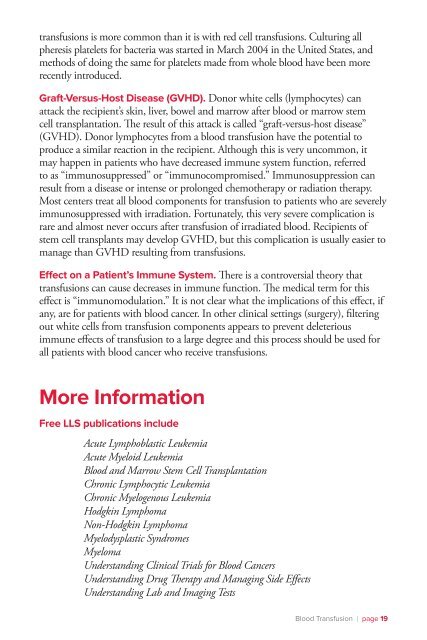Blood Transfusion (PDF) - The Leukemia & Lymphoma Society
Blood Transfusion (PDF) - The Leukemia & Lymphoma Society
Blood Transfusion (PDF) - The Leukemia & Lymphoma Society
You also want an ePaper? Increase the reach of your titles
YUMPU automatically turns print PDFs into web optimized ePapers that Google loves.
transfusions is more common than it is with red cell transfusions. Culturing all<br />
pheresis platelets for bacteria was started in March 2004 in the United States, and<br />
methods of doing the same for platelets made from whole blood have been more<br />
recently introduced.<br />
Graft-Versus-Host Disease (GVHD). Donor white cells (lymphocytes) can<br />
attack the recipient’s skin, liver, bowel and marrow after blood or marrow stem<br />
cell transplantation. <strong>The</strong> result of this attack is called “graft-versus-host disease”<br />
(GVHD). Donor lymphocytes from a blood transfusion have the potential to<br />
produce a similar reaction in the recipient. Although this is very uncommon, it<br />
may happen in patients who have decreased immune system function, referred<br />
to as “immunosuppressed” or “immunocompromised.” Immunosuppression can<br />
result from a disease or intense or prolonged chemotherapy or radiation therapy.<br />
Most centers treat all blood components for transfusion to patients who are severely<br />
immunosuppressed with irradiation. Fortunately, this very severe complication is<br />
rare and almost never occurs after transfusion of irradiated blood. Recipients of<br />
stem cell transplants may develop GVHD, but this complication is usually easier to<br />
manage than GVHD resulting from transfusions.<br />
Effect on a Patient’s Immune System. <strong>The</strong>re is a controversial theory that<br />
transfusions can cause decreases in immune function. <strong>The</strong> medical term for this<br />
effect is “immunomodulation.” It is not clear what the implications of this effect, if<br />
any, are for patients with blood cancer. In other clinical settings (surgery), filtering<br />
out white cells from transfusion components appears to prevent deleterious<br />
immune effects of transfusion to a large degree and this process should be used for<br />
all patients with blood cancer who receive transfusions.<br />
More Information<br />
Free LLS publications include<br />
Acute Lymphoblastic <strong>Leukemia</strong><br />
Acute Myeloid <strong>Leukemia</strong><br />
<strong>Blood</strong> and Marrow Stem Cell Transplantation<br />
Chronic Lymphocytic <strong>Leukemia</strong><br />
Chronic Myelogenous <strong>Leukemia</strong><br />
Hodgkin <strong>Lymphoma</strong><br />
Non-Hodgkin <strong>Lymphoma</strong><br />
Myelodysplastic Syndromes<br />
Myeloma<br />
Understanding Clinical Trials for <strong>Blood</strong> Cancers<br />
Understanding Drug <strong>The</strong>rapy and Managing Side Effects<br />
Understanding Lab and Imaging Tests<br />
<strong>Blood</strong> <strong>Transfusion</strong> I page 19

















